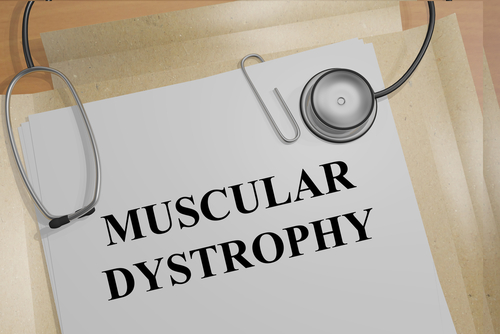Part B of MoveDMD Trial Shows Mixed Efficacy Results for CAT-1004 as Duchenne Treatment

Catabasis Pharmaceuticals reported mixed topline data from Part B of the MoveDMD trial evaluating the safety and efficacy of CAT-1004 (edasalonexent) in treating Duchenne muscular dystrophy (DMD) patients.
MoveDMD is a three-part, multisite Phase 1/2 trial (NCT02439216) evaluating the efficacy, safety, and the pharmacodynamics (PD) and pharmacokinetics (PK), meaning drug’s properties and behavior in the body, of CAT-1004 in boys with DMD. The trial’s co-primary endpoints include the change in muscle composition and inflammation as measured by magnetic resonance imaging (MRI), and safety assessments.
Part A of MoveDMD started in April 2015 and is now complete. All dose levels of CAT-1004 examined were well-tolerated with no major safety events observed. The majority of adverse events were mild and related to gastrointestinal events, mostly diarrhea.
Part B was a randomized, double-blind, placebo-controlled trial evaluating the safety, efficacy, pharmacokinetics, and pharmacodynamics of CAT-1004 over 12 weeks at two dosing levels: 67 mg/kg a day and 100 mg/kg a day. Thirty-one boys were enrolled and all completed the trial.
The trial’s primary efficacy endpoint was not met, Catabasis reported. At 12 weeks, there was no statistically significant changes between CAT-1004 treatment groups (67 mg/kg/day and 100 mg/kg/day) and placebo on lower-leg muscles function as assessed by MRI. Although not achieving statistical significance, patients treated with CAT-1004 at 100 mg/kg/day had improvements across multiple measures compared to placebo-treated patients.
The lower-dose treatment group had varied results compared with both the high-dose and placebo groups, but again, in each case, results did not reach statistical significance. In terms of safety, treatment was well-tolerated at both doses, with no major adverse events reported. As in Part A, gastrointestinal problems, diarrhea, and vomiting were reported, but these were mild in nature.
Part B also evaluated CAT-1004’s efficacy in three age-appropriate timed function tests (10-meter walk/run, 4-stair climb and time to stand), the North Star Ambulatory Assessment (NSAA), and other MRI measures, but there were no statistically significant changes in the clinical outcomes of these measures between treated and placebo patients.
From baseline to 12 week, however, patients treated with CAT-1004 at 100 mg/kg/day had better functioning on all three timed function tests and in NSAA scores, as well as on MRI results for upper leg muscles function compared to placebo. Catabasis also noted that patients in this higher-dose group had characteristics of more advanced DMD at baseline, were diagnosed at a younger age, and did not perform as well on function tests compared to patients in the other study groups.
An open-label extension study, called Part 3, is now underway, with all patients (from Parts A and/or B) invited to continue receiving CAT-1004 for 36 weeks. Data from Part C is expected before year’s end, and an interim analysis is likely by mid-year.
“Although we did not meet the MRI T2 composite end point, the continued safety, tolerability and plasma exposure data in Part B of the MoveDMD trial are reassuring. We observed potential treatment-associated effects at 12 weeks in the 100 mg/kg/day treatment group, which we believe warrant further evaluation to see if the signals strengthen in the longer-term data from the ongoing open-label extension. Following additional data analysis from the open-label extension, we will determine the next steps for edasalonexent in DMD,” Jill C. Milne, chief executive officer of Catabasis said in a press release. “We are enormously grateful to the boys and the families involved in the MoveDMD trial as well as the clinical trial site staff and patient groups who are making this trial possible.”
“The top-line data results from Part B of the MoveDMD trial provide us with an early snapshot of the effects of edasalonexent in boys with DMD over a 12-week period. Continuing the open-label extension of the MoveDMD trial will allow us to further evaluate the potential for edasalonexent to provide benefit in DMD,” said Richard Finkel, MD, division chief, division of Neurology, department of Pediatrics at Nemours Children’s Health System and a study principal investigator. “The unmet medical need in Duchenne is profound and potential therapies that benefit all patients are needed.”
CAT-1004 is as an oral small molecule agent with the potential to be a disease-modifying therapy for all DMD patients regardless of the particular gene mutation underlying their disease. It inhibits NF-kB, a protein that becomes activated in people with Duchenne MD, driving inflammation and fibrosis, muscle degeneration, and that suppresses muscle regeneration.
In preclinical studies, CAT-1004 produced beneficial effects in skeletal, diaphragm and heart muscle and improved function in DMD animal models. The U.S. Food and Drug Administration (FDA) designated CAT-1004 an Orphan Drug, and granted it Fast Track and Rare Pediatric Disease designations. The European Commission has also granted CAT-1004 Orphan Medicinal Product status for the treatment of DMD.






